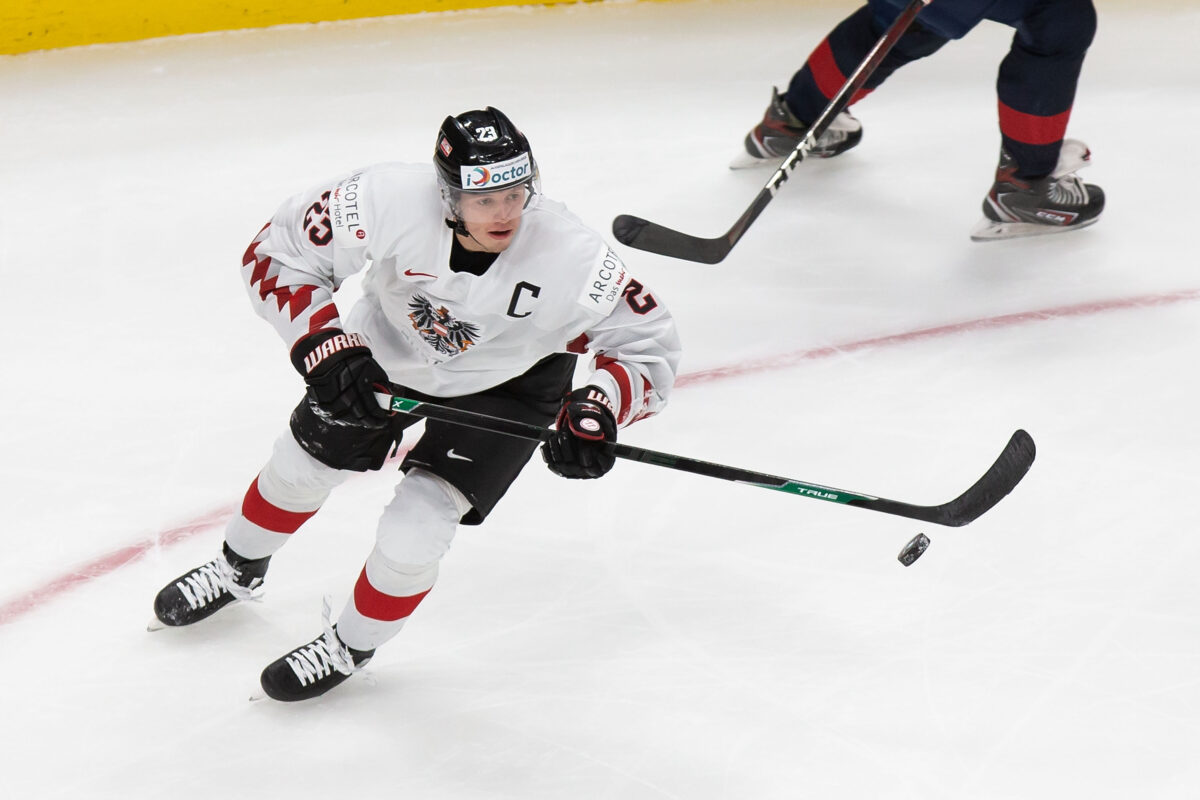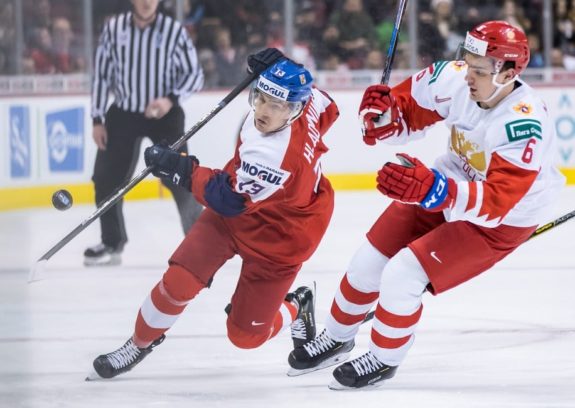People have often wondered why there are 10 teams in the World Junior Championship rather than eight. After all, how many people want to watch Austria get pounded by 10 goals by Team Canada or Team USA? There’s a debate to be had about the number of teams in the tournament, but as Team Germany, Team Slovakia and Team Switzerland prove to be tough opponents for nations expected to be some of the best in hockey, it’s clear that reducing the number of competitors isn’t the answer. It’s time to start thinking about expanding the tournament to 12 teams.
Look How Far Germany Has Come
It wasn’t long ago that people talked about trimming Team Germany from the World Junior roster. It’s easy to see why considering they have never won a medal and have never really put up a fight against the big teams. They were relegated from the top division in 2015 and didn’t return until 2020 when they beat Team Czechia and staved off relegation by beating Kazakhstan in three games.
For many years, the Germans produced a good player here and there who would go onto play in the NHL, but they never really had a superstar. That hurdle was cleared when a young player named Leon Draisaitl was drafted second overall in the 2012 Canadian Hockey League Import Draft by the Prince Albert Raiders. Draisaitl had a great career in the Western Hockey League, playing with both the Raiders and the Kelowna Rockets in the 2014-15 season when his team won the WHL championship, the Ed Chynoweth Cup.

Draisaitl was a star for the Germans at the World Juniors, too. In 2013, he scored six points in six games and helped his team in a key game against the Latvians to decide who was staying and who was going. When Germany was included in the relegation round (with Finland, Slovakia, and Latvia), he scored twice and added two assists as the Germans beat Team Latvia 5-2 and secured their spot at the 2014 World Juniors.
But the 2014 World Juniors were a disaster for Germany. They were out-scored 24-7 and were blown out by Slovakia. In the best-of-three relegation series against Team Norway, they lost the first game 3-0 and had their backs against the wall right off the bat. With the help of four points from Draisaitl over the next two games, Germany came back to win the series and return to the tournament in 2015.
Related: World Juniors Home Page
After losing their superstar, the Germans entered another dark period in their junior hockey program. They spent four years trying to earn a promotion into the top division before winning their way back in 2019 and earning their place at the 2020 World Juniors in Czechia. They may not have had Draisaitl, but they did have a young lineup filled with budding stars who had the potential to turn their program around. Tim Stützle, Moritz Seider, Dominik Bokk, Lukas Reichel, and John-Jason Peterka were all on the 2020 roster, and while they didn’t do more than stave off relegation, it was the sign of big changes for German hockey.

People will remember the Germans being beaten by Canada 16-2 in 2021, but that game was an anomaly, not the norm. If you ignore that one game against a tournament powerhouse, the Germans were good. They played an incredibly close game against the Finns, losing 5-3; they beat Switzerland 5-4, and they beat Slovakia in overtime. Yes, they beat weaker teams, but let’s not forget that those “weaker teams” were virtually unbeatable for the Germans for countless years. They made it to the medal round and played the Russians well but eventually fell 2-1. Progress was being made.
Entering this year’s tournament, people were worried that without the stars that had led the German turnaround, they would flunk out again. Through two games, that hasn’t been the case. Luca Münzenberger, Maksymilian Szuber, and Alexander Blank have all stepped up and admirably filled the boots of those who have departed. The team may not be as dangerous as they were with Stützle, Reichel, and Peterka, but that they are still competitive without their best players says a lot about the development of German hockey. It’s better than it has ever been before, and they are in a good spot to produce more NHLers, more Olympians, and more stars than ever before.
Some Nation Will be the Next Germany
Why should we care that the Germans are getting better? The simple answer: it’s good for the game. In recent years, we have not only seen the Germans close the gap between the rest of the competition, but it has also happened to some extent with Slovakia, Czechia, and Switzerland. No one is including these teams in their medal predictions yet, but given their progress, that could be different in as little as five years?
These smaller hockey nations haven’t yet hit their peak. This is just the start for some of these teams, and if they continue on this path, it won’t be long before they start winning medals now and then. Remember how the Germans started? They were bullied in the tournament as the Austrians are right now. It might sound crazy, but what if the Austrians could follow Germany’s blueprint get themselves to that next step?

If it’s not Austria, it could be Belarus, it could be Latvia, it could be Switzerland, or maybe Denmark. We may not know who or when but it will be some nation. Eventually, a country or many will find the secret elixir and take their national hockey team to the next level.
Related: 2022 Guide To the World Junior Championship
I can guarantee this will start with some massive blowouts. This isn’t an overnight solution, but with time, we could see weaker teams close the gap on the top competition. As they say in economics, a rising tide lifts all boats. Playing against better competition should force smaller nations to get better at the sport, and when or if they do, those middle-of-the-pack teams will also improve before they are eventually competitive with some of the elite nations.
Why Now for the World Juniors?
If there was ever a perfect time for the IIHF to increase the number of teams in the World Juniors, it’s now. After they announced that there would be no relegation this year, they are now in a sticky situation. Belarus has already earned their promotion to the top division for next year, but that will leave them with an odd number of teams. Adding Latvia (who won silver at the Division 1A championship) would make it an even 12, which makes the most sense.

Rolling with the punches is sometimes the smartest thing to do, and being forced to add a 12th team because of COVID might be the perfect time to make it permanent. Since the IIHF has also proven that the dollar can influence their decision-making process, they could also format the tournament so that each team plays five preliminary-round games instead of four. This, of course, would mean that Canada has another game to draw massive viewing numbers, but you would also have two new nations watching games.
Of course, their primary interest should be developing the game of hockey worldwide. The IIHF has already failed to do this for women, and that needs to change, but they could take a step in the right direction by extending the World Juniors to 12 teams. Adding teams to the top tier would force them to try and catch the Germans, the Slovaks, and the Swiss to keep themselves from being on the verge of relegation every year.
More Teams, Better Chance to Grow
It’s no guarantee that every team that gets into the World Juniors will be able to compete with the top teams in the tournament, but a couple of blowout games is a small price to pay for developing the sport, and the IIHF should be willing to pay it. As the bottom teams solidify themselves as hockey nations, they should make room for the next countries to develop their programs against elite competition. We used to have five elite teams playing against five countries that weren’t to beat anyone, but now, we have five elite teams and four who could beat any team on any given night.
Expanding the tournament would be a testament to the growth of the sport over a handful of years. Getting more teams into the mix could do wonders for player development, and while people complain about watering down the talent pool, the IIHF could counteract that by encouraging more nations to focus on their player development from the grassroots level and beyond.
| Team Canada | Players to Watch | Roster |
| Team USA | Players to Watch | Roster |
| Team Austria | Players to Watch | Roster |
| Team Czechia | Players to Watch | Roster |
| Team Finland | Players to Watch | Roster |
| Team Germany | Players to Watch | Roster |
| Team Latvia | Roster | |
| Team Slovakia | Roster | |
| Team Sweden | Players to Watch | Roster |
| Team Switzerland | Players to Watch | Roster |
Guide to the 2022 World Junior Championship
2022 World Juniors Schedule, Groups, Rosters, Predictions & More
One Player to Watch From Each Team
Breakout Candidates & Sleeper Prospects
Predictions for the 2022 World Junior Championship
Award Contenders and Predictions
2022 World Juniors: 2023 Draft-Eligible Players to Watch
6 Predictions for the 2022 World Junior Championship
All Your THW 2022 World Junior Championship Coverage
